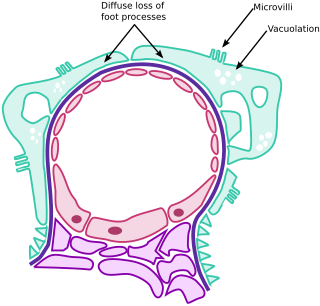Optic neuritis is a demyelinating inflammation of the optic nerve. It is also known as optic papillitis and retrobulbar neuritis. It is most often associated with multiple sclerosis, and it may lead to complete or partial loss of vision in one or both eyes.

Cortisone is a pregnane (21-carbon) steroid hormone. It is one of the main hormones released by the adrenal gland in response to stress. In chemical structure, it is a corticosteroid closely related to cortisol. It is used to treat a variety of ailments and can be administered intravenously, orally, intra-articularly, or transcutaneously. Cortisone suppresses the immune system, thus reducing inflammation and attendant pain and swelling at the site of the injury. Risks exist, in particular in the long-term use of cortisone.

Transcortin, also known as corticosteroid-binding globulin (CBG) or serpin A6, is a protein that in humans is encoded by the SERPINA6 gene. It is an alpha-globulin.
ATC code D07Corticosteroids, dermatological preparations is a therapeutic subgroup of the Anatomical Therapeutic Chemical Classification System, a system of alphanumeric codes developed by the WHO for the classification of drugs and other medical products. Subgroup D07 is part of the anatomical group D Dermatologicals.

Fluticasone propionate, sold under the brand names Flovent and Flonase among others, is a steroid medication. When inhaled it is used for the long term management of asthma and COPD. In the nose it is used for hay fever and nasal polyps.

Minimal change disease is a disease affecting the kidneys which causes a nephrotic syndrome. Nephrotic syndrome leads to the loss of significant amounts of protein in the urine, which causes the widespread oedema and impaired kidney function commonly experienced by those affected by the disease. It is most common in children and has a peak incidence at 2 to 6 years of age. MCD is responsible for 10-25% of nephrotic syndrome cases in adults. It is also the most common cause of nephrotic syndrome of unclear cause (idiopathic) in children.

Triamcinolone diacetate is a synthetic glucocorticoid corticosteroid and a corticosteroid ester.

Flunisolide is a corticosteroid often prescribed as treatment for allergic rhinitis. Intranasal corticosteroids are the most effective medication for controlling symptoms.

Alclometasone dipropionate is a synthetic glucocorticoid corticosteroid and a corticosteroid ester.

Fluorometholone acetate is a synthetic glucocorticoid corticosteroid and a corticosteroid ester. It is the acetate ester of fluorometholone.

Tixocortol is a corticosteroid used as an intestinal anti-inflammatory and decongestant.

Prednicarbate is a relatively new topical corticosteroid drug. It is similar in potency to hydrocortisone. Compared to other topical corticosteroids, like betamethasone, repeated prednicarbate use does not cause skin atrophy as quickly. Corticosteroids have always been an important part of the pharmacological arsenal of dermatology; however, their tendency to produce side-effects has caused the need to search for new preparations.

Clobetasone butyrate is a synthetic glucocorticoid corticosteroid and a corticosteroid ester.

Ulobetasol propionate, also known as halobetasol propionate, is a synthetic glucocorticoid corticosteroid and a corticosteroid ester.

Fluprednisolone is a pregnane. It is a corticosteroid.

Paramethasone acetate is a synthetic glucocorticoid corticosteroid and a corticosteroid ester. It is the acetate ester of paramethasone.

Chloroprednisone acetate is a synthetic glucocorticoid corticosteroid and a corticosteroid ester. It is the 21-acetate ester of chloroprednisone.

Flumetasone pivalate is a synthetic glucocorticoid corticosteroid and a corticosteroid ester. It is the 21-acetate ester of flumetasone.


















